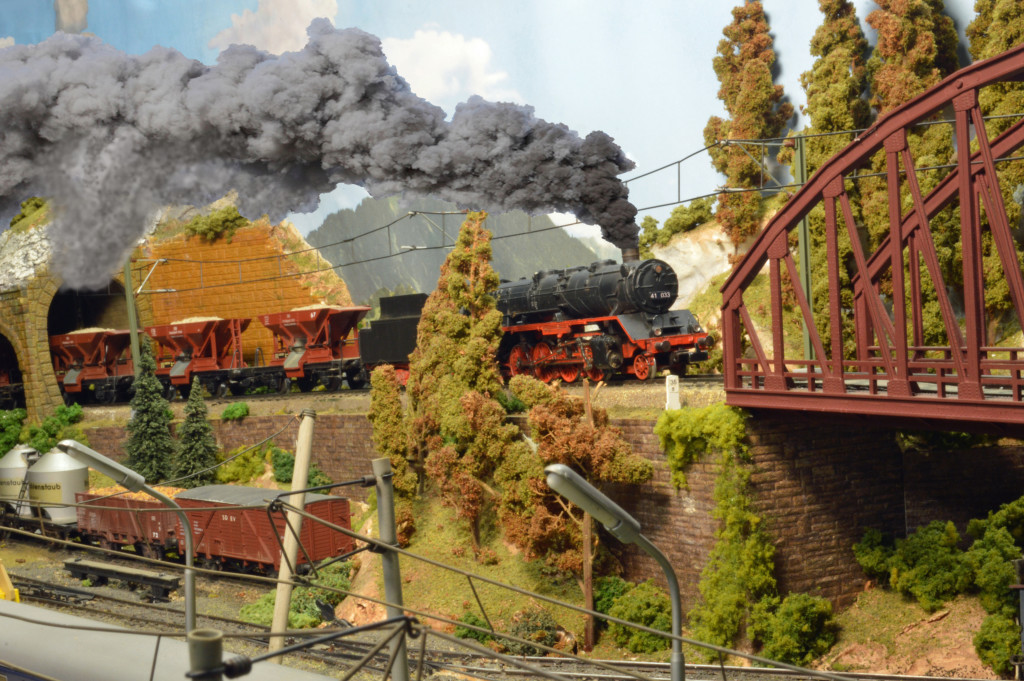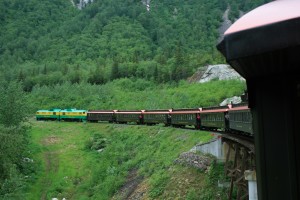You are browsing archives for
Category: Articles
How to’s, presentations, and informational articles
A Narrower View – Common Carriers
Syd Schofield
Editors note: Welcome to the ninth article of a series on narrow gauge by Syd Schofield. The previous article is available by clicking here, or by filtering with the category “Narrow Gauge”. Syd welcomes discussions and feedback, which can be made by clicking on the comment link at the bottom of the post.
In the early days of railroading the track gauge was still up for grabs in many areas and the idea of rolling stock interchange was a question of common track gauge. The typical accommodation is to install dual gauge track. While there were a few exceptions where some lines actually had provisions for swapping the undercarriage on rolling stock to accommodate the gauge change, the Russians and Chinese actually still do that on the Trans-Siberian Railway. Then, too, they have more serious cultural and political problems than did the North American lines where the typical accommodation was a dual gauge track. There were a few lines in the Colorado neighborhood that did exchange equipment on cooperative business arrangements too complex for this discussion.
An Introduction to Free-mo, Part 1: Exploring this Form of Model Railroading
by Alan Ashton
Editors note: Alan Ashton is the former 5th Division newsletter editor and is now promoting and explaining Free-mo. This article has been updated to clarify the Digitrix Loconet requirements as noted by Mark Clemmens in his comment. Articles on Free-mo from other authors are very appreciated and can be sent to gi_editor@4dpnr.com. Alan can be reached at inwafreemo@gmail.com.
I have been a model railroader for many years and it didn’t take too long for me to decide that I would like to build a Free-mo module. My reasons for doing so include:
- Building and storing a module won’t take up much space
- Having a module will enable me to meet and interact with more people who share a common interest
- Construction costs won’t be prohibitive
- I will learn about new materials and techniques
- I have the time and interest to learn about a new aspect of my favorite hobby
Photos From Oregon Rail Heritage Center Tour During PDX 2015
Alex Brikoff
When I and my wife Tina attended PDX 2015 in Portland, OR this summer, one of the tours we took was to the Oregon Rail Heritage Center. It’s definitely worthwhile! It’s not a large collection but certainly well represented. It’s one of the few places that one can get up close and personal with some the legends of Northwest rail history such as the SP X4449, the SP&S 700 and the Oregon Railroad and Navigation #197 (as well as other exhibits and restored railroad equipment). While we were there, they were in the process of overhauling #4449. Until I got fairly close to it, I simply didn’t realize how massive this locomotive really was! I hope you enjoy my photos!
Editors note: Alex loves to shoot black and white art photography, specially local jazz artists. Check out his website at http://alexbrikoff.com.
A Narrower View – Rolling with a Purpose
Syd Schofield
Editors note: Welcome to the eighth article of a series on narrow gauge by Syd Schofield. The previous article is available by clicking here, or by filtering with the category “Narrow Gauge”. Syd welcomes discussions and feedback, which can be made by clicking on the comment link at the bottom of the post.
Transportation for supporting human needs and wants has evolved from walking to rockets in space. In the not-too-distant past we managed to develop materials and technology to enhance this transportation. For the most part we move along the surface of the earth – land and water. Moving on water, once the buoyancy problems were solved, required an application of power. Wind and current were free if the direction of travel was favorable. Travelling on still water, going against the wind or moving upstream, required some extra effort.
A Narrower View – Monsters and Miniatures
Syd Schofield
Editors note: Welcome to the seventh article of a series on narrow gauge by Syd Schofield. The previous article is available by clicking here, or by filtering with the category “Narrow Gauge”. Syd welcomes discussions and feedback, which can be made by clicking on the comment link at the bottom of the post.
Well into the Machine Age, when cast iron foundries and machine shops were as common as weaving mills and breweries, the narrow gauge locomotives had many folks involved in their creation and development. The wheel arrangements were many and varied, not so much for pulling power and speed as for the capability of the rail and support systems. The smallest possible wheel arrangement (prior to the imaginary Smokey Stover Fire Chief car or the modern gyro-stabilized Segway) was the 0-4-0 and the 2-2-2, the middle number(s) being the number of driving wheels, capable of pulling only minimal consists (in the later years the 2-2-2 served as the power plant configuration for VIP and inspection cars) lightly rolling on small rail and primitive roadbed. The largest was the 2-8-2 and the 2-6-6-2 that required significant infrastructure but could pull dozens of car consists.
A Narrower View – Exceptions
Syd Schofield
Editors note: Welcome to the sixth article of a series on narrow gauge by Syd Schofield. The previous article is available by clicking here, or by filtering with the category “Narrow Gauge”. Syd welcomes discussions and feedback, which can be made by clicking on the comment link at the bottom of the post.
Most of the narrow gauge railroads were driven by the advantages of scale. The ability to negotiate tighter curves, smaller tunnels and bridges, narrower roadbed preparation and shorter ties were the chief advantages for narrow gauge lines over standard gauge railroads and became the chief reasons for being. The disadvantages of the accompanying smaller equipment were compensated by longer trains and more frequent service. However, in some remote regions, sparsely populated by industries and humanity, the cheaper infrastructure became the sole advantage as volumes to be transported were thin.
A Narrower View – Feeding the Dragons
Syd Schofield
Editors note: Welcome to the fifth article of a series on narrow gauge by Syd Schofield. The previous article is available by clicking here, or by filtering with the category “Narrow Gauge”. Syd welcomes discussions and feedback, which can be made by clicking on the comment link at the bottom of the post.
The common sources of energy for heat engines have been wood, coal, and petroleum products. These carbon based fuels combine with oxygen at a sufficient temperature for a continuous release of heat. In the railroading scheme of things this heat is then converted to mechanical energy to provide locomotion. Since the system for this activity is self-contained, adequate carriage must be provided for the conversion mechanism and the fuel for a reasonable distance of travel. Provisions must be made along the route for replenishment.
Return to the White Pass & Yukon Railroad
By Lee Bishop
Early in the morning on May 27, 2015, my wife and I arrived at Skagway, Alaska to ride the 3-foot gauge White Pass & Yukon Railroad. We had arrived on the cruise ship Norwegian Jewel out of Seattle for a round trip to Skagway and stops in between. For me, the White Pass was the highlight of the trip for the activities ashore.
Pan Am Railways Shop Tour, Waterville, Maine
George Chambers
The Pan Am Railways began in 1981 as the Guilford Transportation Industries and consists of the former Boston and Maine, Maine Central, Portland Terminal Co. and the Springfield Terminal Railway. The railroad runs from Mattawamkeag, Maine to Rotterdam Jct. New York. The name was changed to Pan Am Railways in 2006 when owner Tim Mellon bought the “Pan Am” trademark name from the defunct airline. The railway HQ is in North Billerica, MA.
While on a vacation trip on May 19, 2015, my wife Sally and I toured the locomotive and car shop of the Pan Am Railways. Sally’s brother Dick is on the board of directors for the railway and set up the tour for us.


